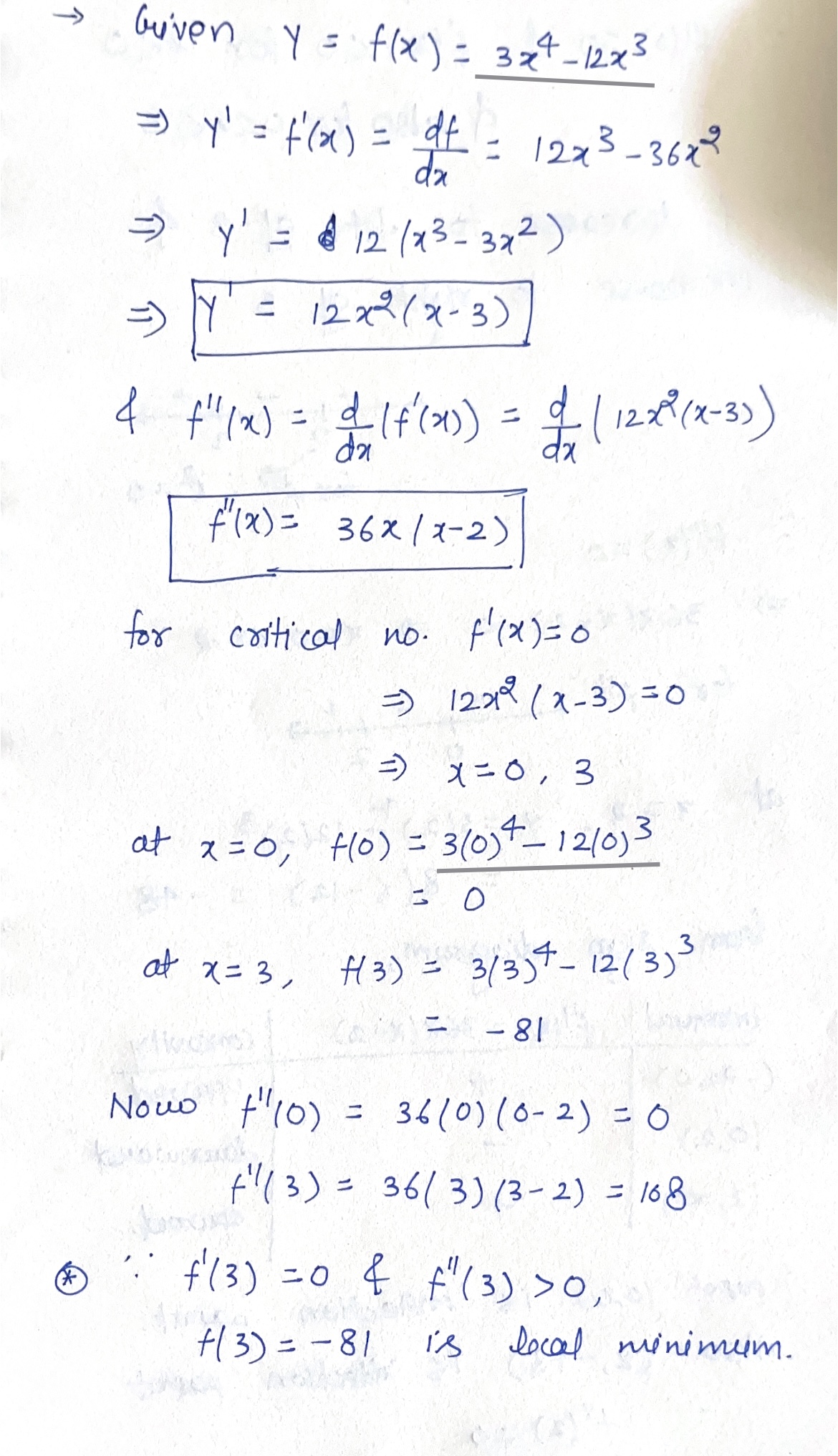Glencoe Algebra 1, Student Edition, 9780079039897, 0079039898, 2018
18th Edition
ISBN:9780079039897
Author:Carter
Publisher:Carter
Chapter3: Linear And Nonlinear Functions
Section: Chapter Questions
Problem 26MCQ
Related questions
Question
![Discuss the curve y = 3x4 - 12x³ with respect to concavity, points of inflection, and local maxima and minima. Use this information to sketch the curve.
Solution
If f(x)= 3x4 12x3, then
f'(x) = 12x³ - 36x² = 12x²(x - 3)
f"(x) = 36x²72x = 36x(x - 2).
To find the critical numbers we set f'(x) = 0 and obtain x = 0 and x =
To use the Second Derivative Test we evaluate f" at the following critical numbers.
f"(0) =
f"(3) =
Since f'(3) =
and f"(3) > 0, f(3) =
is a local minimum. Since f"(0) =
expression for f'(x) shows that f decreases to the left of 3 and increases to the right of 3.]
Since f"(x) = 0 when x = 0 or x =
Interval
(-00, 0)
,00)
F"(x) = 36x(x - 2) Concavity
+
upward
we divide the real line into intervals with these numbers as endpoints and complete the following chart.
downward
-48
-81
upward
The point (0, 0) is an inflection point since the curve changes from concave upward to concave downward there. Also,
Using the local minimum, the intervals of concavity, and the inflection points, we sketch the curve in the figure.
2
the Second Derivative Test gives no information about the critical number 0. But since f'(x) < 0 for x < 0 and also for 0 < x < 3, the First Derivative Test tells us that f does not have a local maximum or minimum at 0. [In fact, the
3
X
Ⓡ
, -48 is an inflection point since the curve changes from concave downward to concave upward there.](/v2/_next/image?url=https%3A%2F%2Fcontent.bartleby.com%2Fqna-images%2Fquestion%2Fa99b667d-9c5e-4348-ae27-7267dcf798d1%2Fd3ba353d-9fa7-4590-894d-c11931d2e191%2F8jo5blr_processed.png&w=3840&q=75)
Transcribed Image Text:Discuss the curve y = 3x4 - 12x³ with respect to concavity, points of inflection, and local maxima and minima. Use this information to sketch the curve.
Solution
If f(x)= 3x4 12x3, then
f'(x) = 12x³ - 36x² = 12x²(x - 3)
f"(x) = 36x²72x = 36x(x - 2).
To find the critical numbers we set f'(x) = 0 and obtain x = 0 and x =
To use the Second Derivative Test we evaluate f" at the following critical numbers.
f"(0) =
f"(3) =
Since f'(3) =
and f"(3) > 0, f(3) =
is a local minimum. Since f"(0) =
expression for f'(x) shows that f decreases to the left of 3 and increases to the right of 3.]
Since f"(x) = 0 when x = 0 or x =
Interval
(-00, 0)
,00)
F"(x) = 36x(x - 2) Concavity
+
upward
we divide the real line into intervals with these numbers as endpoints and complete the following chart.
downward
-48
-81
upward
The point (0, 0) is an inflection point since the curve changes from concave upward to concave downward there. Also,
Using the local minimum, the intervals of concavity, and the inflection points, we sketch the curve in the figure.
2
the Second Derivative Test gives no information about the critical number 0. But since f'(x) < 0 for x < 0 and also for 0 < x < 3, the First Derivative Test tells us that f does not have a local maximum or minimum at 0. [In fact, the
3
X
Ⓡ
, -48 is an inflection point since the curve changes from concave downward to concave upward there.
Expert Solution
Step 1: step by step sol

Trending now
This is a popular solution!
Step by step
Solved in 3 steps with 3 images

Recommended textbooks for you

Glencoe Algebra 1, Student Edition, 9780079039897…
Algebra
ISBN:
9780079039897
Author:
Carter
Publisher:
McGraw Hill

College Algebra
Algebra
ISBN:
9781305115545
Author:
James Stewart, Lothar Redlin, Saleem Watson
Publisher:
Cengage Learning

Algebra: Structure And Method, Book 1
Algebra
ISBN:
9780395977224
Author:
Richard G. Brown, Mary P. Dolciani, Robert H. Sorgenfrey, William L. Cole
Publisher:
McDougal Littell

Glencoe Algebra 1, Student Edition, 9780079039897…
Algebra
ISBN:
9780079039897
Author:
Carter
Publisher:
McGraw Hill

College Algebra
Algebra
ISBN:
9781305115545
Author:
James Stewart, Lothar Redlin, Saleem Watson
Publisher:
Cengage Learning

Algebra: Structure And Method, Book 1
Algebra
ISBN:
9780395977224
Author:
Richard G. Brown, Mary P. Dolciani, Robert H. Sorgenfrey, William L. Cole
Publisher:
McDougal Littell

Algebra & Trigonometry with Analytic Geometry
Algebra
ISBN:
9781133382119
Author:
Swokowski
Publisher:
Cengage